Investment Thesis
I last reviewed the ProShares S&P 500 Dividend Aristocrats ETF (BATS:NOBL) on February 5, 2024, noting how the portfolio’s removal of Walgreens Boots Alliance, Inc. (WBA) was positive, NOBL remained inferior to the Vanguard Dividend Appreciation Index Fund ETF Shares (VIG) from a growth, quality, and total returns perspective. Since that review was published, NOBL has lagged VIG by 2.25% (12.09% vs. 9.84%), while the Schwab U.S. Dividend Equity ETF (SCHD) and the SPDR S&P 500 ETF Trust (SPY) gained 10.60% and 14.16%, respectively.
Seeking Alpha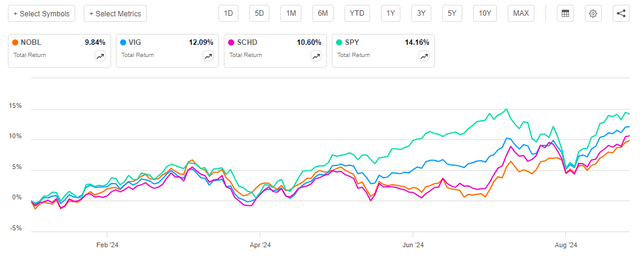
In this update, I will compare NOBL fundamentally with VIG, SCHD, and SPY and summarize why I don’t believe it’s the best solution for your dividend growth portfolio. I hope you enjoy the review.
NOBL Overview
Strategy Discussion and Performance Analysis
NOBL tracks the S&P 500 Dividend Aristocrats Index, selecting S&P 500 Index stocks with at least 25 years of consecutive dividend increases. Due to this high barrier to entry, portfolio turnover is relatively low (22% for the most recent fiscal year), and exposure to Technology stocks is limited. While mega-cap tech stocks like Apple Inc. (AAPL) and Microsoft Corporation (MSFT) enjoy Dividend Achievers status with 10+ years of consecutive increases, it will be a while before they get added to NOBL. This approach has proved especially detrimental to shareholders in recent years, but at the same time, NOBL could be a way to reduce risk. That’s a big part of the pitch, too. Its fact sheet notes the following:
1. NOBL’s holdings are the S&P 500 Dividend Aristocrats: high-quality companies that have not just paid dividends but grown them for at least 25 consecutive years, with most doing so for 40 years or more.
2. Often household names, NOBL’s holdings generally have had stable earnings, solid fundamentals, and strong histories of profit and growth.
3. NOBL’s strategy has a demonstrated history of weathering market turbulence over time by capturing most of the gains of rising markets and fewer losses in falling markets.
The last statement is worth challenging, as it really speaks to why investors would choose NOBL over SPY in the first place. As shown below, NOBL has done better in down markets, averaging a 0.31% monthly beat since November 2013. However, it’s also lagged by 0.41% per month in up markets, so the statement is not entirely accurate.
Portfolio Visualizer
Furthermore, the statement does not address frequency. Markets generally rise, just not every year. Therefore, to outperform, NOBL needs to generate more alpha in down markets than it does in up markets. Since this was not the case and up markets outnumbered down markets by more than 2:1 (91 vs. 39), the end result was NOBL lagging SPY by 2.52% per year.
Portfolio Visualizer
To some investors, that’s acceptable because NOBL has demonstrated it can outperform substantially in down market years like in 2022. However, I want to remind readers that NOBL is one of many funds capable of doing so. Over the same period, VIG and SCHD have delivered superior total and risk-adjusted returns, including some decent downside protection in years like 2015, 2018, and 2022.
Portfolio Visualizer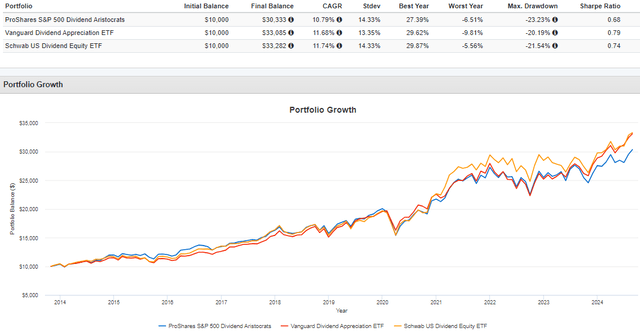
NOBL Dividend Overview
NOBL pays dividends quarterly and yields 2.04% on a trailing basis. The 15.98% ten-year dividend growth rate noted below isn’t accurate, as NOBL has not yet been around for the required 11 years to calculate this statistic. Its dividend growth track record is reasonably solid, aided by 16.09% growth over the last twelve months.
Seeking Alpha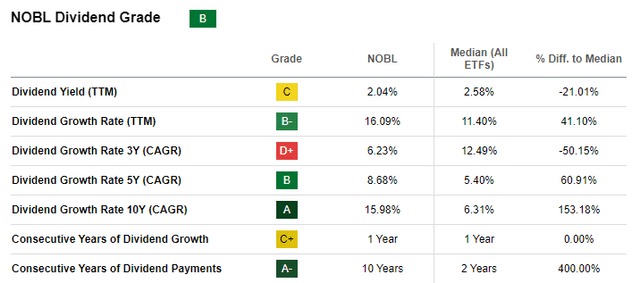
Still, VIG and SCHD have better dividend growth track records. These funds have double-digit five-year dividend growth rates compared to 8.68% for NOBL. In VIG’s case, it looks sustainable because it’s supported by sufficient historical and forecasted earnings growth.
Seeking Alpha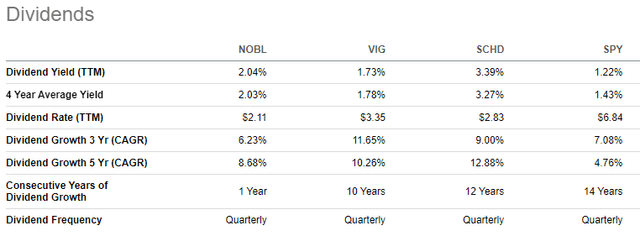
Lastly, I ask readers to consider the number of consecutive dividend increases required to deem a company “safe.” NOBL requires 25 years, and its constituents have increased by 35 straight years on average. However, VIG and SCHD’s numbers are pretty solid at 21 and 19 years, which, in my view, is enough. The approach made more sense ten years ago, but today, NOBL excludes too many high-quality companies without even offering a better dividend yield or dividend growth rate than lower-cost peers.
NOBL Analysis
Sector Allocations and Top Ten Holdings
The following table highlights the sector allocation differences between NOBL, VIG, SCHD, and SPY. In addition to its minimal Technology sector exposure, NOBL is light on Communication Services, Consumer Discretionary, Energy, Real Estate, and Utilities. Instead, nearly half of the portfolio comprises stocks in Consumer Staples (24.53%) and Industrials (22.63%).
The Sunday Investor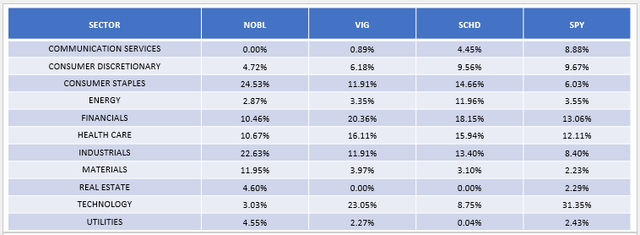
Compared to SCHD and SPY, it’s less diversified, which I believe diminishes its ability to manage risk in various market environments. However, VIG’s diversification is potentially worse, and it makes sense to consider multiple ETFs in these cases. In NOBL’s case, it has 27.79%, 11.88%, and 13.14% overlap with VIG, SCHD, and SPY, so if you are a NOBL shareholder and don’t want to part with it, complementing it with either of these ETFs makes sense.
NOBL’s top ten holdings are below, totaling 16.49% of the portfolio. The top stock is Kenvue Inc. (KVUE), the consumer health stock that spun off from Johnson & Johnson (JNJ) last year. As a spin-off, the rules allowed Kenvue to retain JNJ’s dividend growth history, allowing both stocks to enter the Index.
ProShares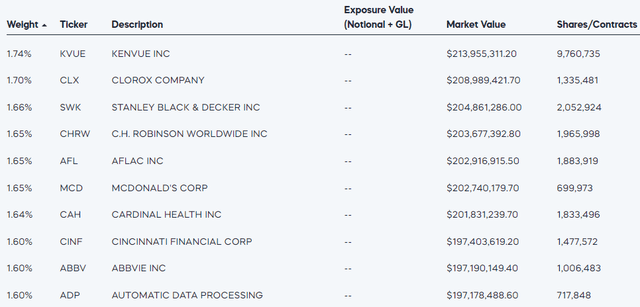
Stanley Black & Decker, Inc. (SWK) and Cincinnati Financial Corporation (CINF) are on 55- and 63-year dividend growth streaks, joining 19 others with 50+ years of increasing regular annual dividend payments. However, drawbacks to this strategy include lower growth and the potential for company management to cut a dividend, even if it’s in the best interest of the shareholders.
NOBL Fundamentals By Sub-Industry
The following table highlights selected fundamental metrics for NOBL’s top 25 sub-industries, totaling 75.05% of the portfolio. I’ve also included summary metrics for VIG, SCHD, and SPY at the bottom.
The Sunday Investor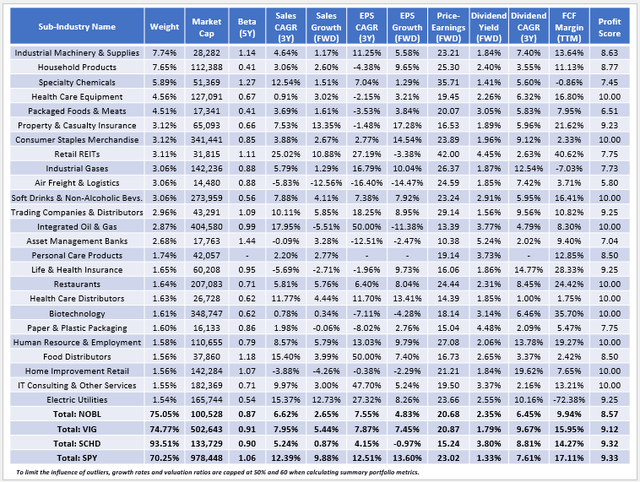
Here are four observations:
1. NOBL trades at 20.68x forward earnings, which is almost identical to VIG’s valuation but comes with substantially less estimated earnings growth (4.83% vs. 7.45%). Therefore, from a growth-at-a-reasonable-price perspective, NOBL isn’t attractive. There is also a similar gap in estimated one-year sales growth (2.65% vs. 5.44%).
2. NOBL’s constituents have a weighted average of 2.35% dividend yield, and after deducting the fund’s 0.35% expense ratio, shareholders should net 2.00% at current prices. VIG and SCHD have 0.06% expense ratios, meaning their expected dividend yields are 1.73% and 3.74%, respectively. All are improvements over SPY, though lower-cost S&P 500 Index funds like SPLG, VOO, and IVV will yield approximately 1.30%.
3. NOBL’s selections have grown dividends by an annualized 6.45% over the last three years, which is about 1-3% less than VIG, SCHD, and SPY. This dividend growth was supported by the portfolio’s 7.55% three-year earnings per share growth rate, but I caution one-year estimated earnings growth is lower at 4.83%. If this holds, the result will either be smaller dividend increases or higher dividend payout ratios. Right now, there is sufficient room to keep the dividend growth rate at 6-7% while still keeping the payout ratio below its four-year average (45.84% vs. 50.75%). However, the payout ratio can quickly spiral out of control, as with SCHD. Its payout ratio also used to be below 50% but is now up to 63% due to negative earnings growth.
The Sunday Investor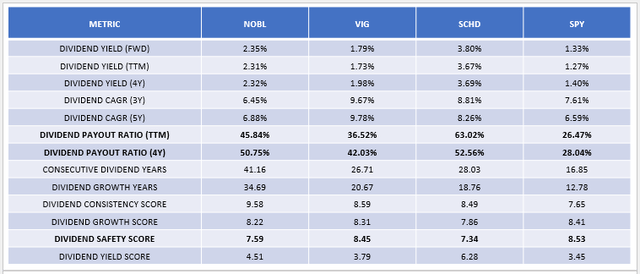
NOBL has a 7.59/10 Dividend Safety Score, which I derived using individual Seeking Alpha Factor Grades. This score is better than SCHD but worse than VIG and SPY, and I rely on it when analyzing dividend ETFs because it’s comprehensive. For example, Clorox’s “C+” Dividend Safety Grade notes its relatively high 77.99% dividend payout ratio and disappointing 0.81% free cash flow to dividend yield ratio.
Seeking Alpha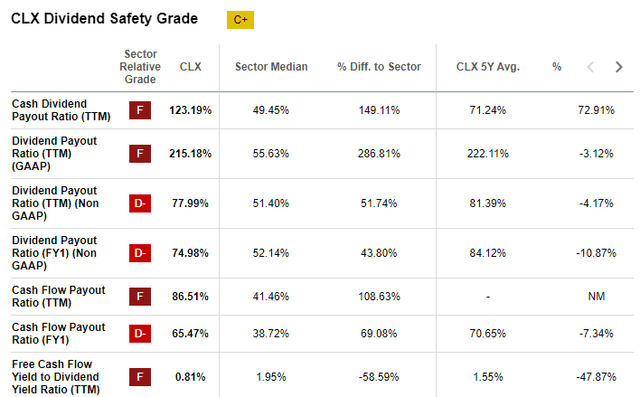
4. NOBL’s 9.94% free cash flow margin figure is low compared to its peers. To be sure, most of this relates to its unique composition. For example, the average tech stock in the S&P 500 Index has 17.72% free cash flow margins compared to 8.33% for those in the Consumer Staples sector. However, the composition doesn’t fully account for the difference. One piece of evidence is NOBL’s 8.57/10 sector-adjusted profit score. The score ranks just #81/102 in the large-cap blend category, which challenges the idea that such an extensive dividend growth track record equates to strong quality. In my view, 25 years is just an arbitrary number. You don’t need it, and something like 10+ years is a more reasonable minimum.
Investment Recommendation
Better alternatives to NOBL exist. VIG, SCHD, and SPY offer different levels of income that can appeal to a wide variety of investors, but neither compromises quality. NOBL’s poor sector-adjusted profit score suggests several holdings are raising dividends when they probably shouldn’t, likely to maintain their reputation as financially strong companies. In addition, VIG offers more earnings growth than NOBL and has the same valuation, and NOBL’s historical outperformance vs. SPY in down markets has yet to offset its underperformance in up markets, which occur more frequently. Therefore, I’ve decided to reiterate my “hold” rating and encourage current shareholders to explore alternatives. Thank you for reading.
Read the full article here
